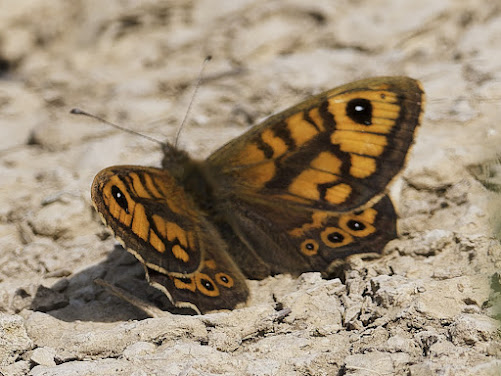On a gloriously sunny morning 11 of us met at Durlston Country Park for a general interest walk, the coastline here forms part of England’s only natural World Heritage Site, the Jurassic Coast.
_AS_20230518.JPG) |
Field Madder was flowering in the car park kerb and an overgrown copse by the car park produced a few flowering stems of Common Twayblade, often overlooked due to its mainly green colouration. We then headed out beyond the learning centre into the meadows which were covered in swathes of Bulbous Buttercups,Yellow Rattle,
 |
Gentianella amarella anglicafasciated example. Further on Spotted Medick & Horseshoe Vetch were seen as was a single Bloody-nose beetle larva and several butterflies including Red Admiral, Peacock, Holly Blue, Small Heath and Wall Brown.
_AS_230518.JPG) |
 | ||||
 |
| Wall Brown © Richard Smith |
 |
We meandered around more meadows where Pale Flax, Sainfoin, Common Vetch and Ox-eye Daisies jostled with buttercups. Leaving the meadows and joining the upper downland path a freshly emerged Black-tailed Skimmer was spotted sunning itself on some stones while further along the path Wild Clary was coming into bloom, Crosswort was flowering as were more Early Purple Orchids. Around the meadows many birds were seen or heard including Long-tailed Tit, Blackcap, Whitethroat, Dunnock, Skylark, Cetti’s Warbler, Kestrel, Linnet, Meadow Pipit, Bullfinch and Buzzard.
Some of our group had joined us for the morning only, those remaining went down through woods and up onto the hillocks above the coastal slope where we stopped for lunch, here we were joined by a Herring Gull who was hoping for tidbits to eat, whilst overhead a Swift flew by. We also surprised two Roe deer who bounded over the hillock to be stopped by the sight of us and bounded off in a different direction.
After lunch we did a little detour to see some rare Goldeneye lichen on an old Hawthorn tree, until 2005 it was considered extinct in the UK having disappeared because of high sulphur dioxide levels through the 1900s.
 |
Retracing our route back onto the slope to the west of the lighthouse some wonderfully large specimens of Horse Mushroom were found, reluctantly we resisted picking them for breakfast! Along the coast path the Thrift and Sea Campion were in full flower and Sea Beet was in bud. Along the west facing wall of the lighthouse compound were many Eastern Gladioli, Green-winged Orchids were also found near the wall. Mouse-eared Hawkweed was flowering well whilst Ravens perched on the mile posts to the irritation of other corvids.
 |
| Ravens © Richard Smith |
 |
| Guillemot colony © Richard Smith |
 | |
| Fulmar © Richard Smith |
From the cliffs we watched Guillemots on the water and ledges, the second largest colony on the south coast after Berry Head in Devon. Also seen were Razorbills, Cormorant, Shags, two Gannet and good views of Fulmar gliding by while a Grey Seal swam past. We finished our walk by the Globe with some of us stopping for tea in the castle before heading home. A&SS
Our route
© Crown copyright 2023 Ordnance Survey.
Media 006/23.
The licence is valid until 31 December 2023



